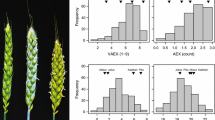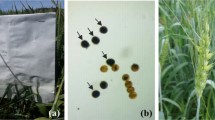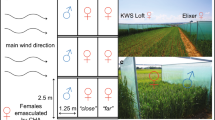Abstract
Key message
Hybrid durum has a promising yield potential coupled with good quality, but the efficiency of hybrid seed production must be improved.
Abstract
Hybrid breeding is a tremendous success story in many crops, but has not yet made a breakthrough in wheat, mainly due to inefficient hybrid seed production. In this study, we investigated the heterosis for grain yield and important quality traits in durum wheat of 33 hybrids built up from 24 parental lines, as well as the variation in anther extrusion and its genetic architecture in a vast collection of Central European elite durum lines. Average mid-parent heterosis for grain yield was 5.8%, and the best hybrids had a more than one ton per hectare higher grain yield than the best line cultivars. Furthermore, hybrids had a higher grain yield than lines at a given level of protein content or sedimentation value, underpinning their potential for a sustainable agriculture. However, seed set in our experimental hybrid seed production was low. We therefore evaluated 315 elite durum lines for visual anther extrusion, which revealed a large genetic variance and a heritability of 0.66. Results from association mapping suggest a mainly quantitative inheritance of visual anther extrusion with few putative QTL being identified, the largest one explaining less than 20% of the genotypic variance. Genome-wide prediction taking the four largest putative QTL into account yielded a mean cross-validated prediction ability of 0.55. Consequently, breeding for improved male floral characteristics is feasible in durum wheat, but should be mainly based on phenotypic selection.





Similar content being viewed by others
References
Aulchenko YS, Ripke S, Isaacs A, van Duijn CM (2007) GenABEL: an R library for genome-wide association analysis. Bioinformatics 23:1294–1296
Avni R, Nave M, Barad O et al (2017) Wild emmer genome architecture and diversity elucidate wheat evolution and domestication. Science 357:93–97
Boeven PHG, Longin CFH, Leiser WL, Kollers S, Ebmeyer E, Würschum T (2016) Genetic architecture of male floral traits required for hybrid wheat breeding. Theor Appl Genet 129:2343–2357
Boeven PHG, Würschum T, Julia R, Erhard E, Longin CFH (2018) Hybrid seed set in wheat is a complex trait but can be improved indirectly by selection for male floral traits. Euphytica 214:110
Borghi B, Perenzin M (1994) Diallel analysis to predict heterosis and combining ability for grain yield, yield components and bread-making quality in bread wheat (T. aestivum). Theor Appl Genet 89:975–981
Bradbury PJ, Zhang Z, Kroon DE, Casstevens TM, Ramdoss Y, Buckler ES (2007) TASSEL: software for association mapping of complex traits in diverse samples. Bioinformatics 23:2633–2635
CNR InterOmics (2017) CNR InterOmics Consortium. https://www.interomics.eu/wild-emmer-wheat-genome. Accessed 26 Oct 2017
Coors JG, Pandey S (1999) The genetics and exploitation of heterosis in crops. ASA, CSSA, and SSSA, Madison
Corbellini M, Perenzin M, Accerbi M, Vaccino P, Borghi B (2002) Genetic diversity in bread wheat, as revealed by coefficient of parentage and molecular markers, and its relationship to hybrid performance. Euphytica 123:273–285
d’Souza L (1970) Untersuchungen über die Eignung des Weizens als Pollenspender bei der Fremdbefruchtung, verglichen mit Roggen, Triticale und Secalutricum. Z Pflanzenzucht 63:246–269 (in German)
De Vries AP (1971) Flowering biology of wheat, particularly in view of hybrid seed production—a review. Euphytica 20:152–170
Endelman JB (2011) Ridge regression and other kernels for genomic selection with R package rrBLUP. Plant Genome 4:250–255
Endelman JB, Jannink J-L (2012) Shrinkage estimation of the realized relationship matrix. G3 Genes Genomes. Genet 2:1405–1413
Geiger HH, Miedaner T (1999) Hybrid rye and heterosis. In: Coors JG, Pandey S (eds) Genetics and exploitation of heterosis in crops. Crop Science Society of America, Madison, WI, pp 439–450
Gilmour AR, Gogel BG, Cullis BR, Thompson R (2009) ASReml user guide release 3.0. VSN International Ltd, Hertfordshire. http://www.vsni.co.uk
Gowda M, Kling CK, Würschum T, Liu W, Maurer HP, Hahn V, Reif JC (2010) Hybrid breeding in durum wheat: heterosis and combining ability. Crop Sci 50:2224–2230
IWGSC et al (2018) Shifting the limits in wheat research and breeding using a fully annotated reference genome. Science 361:eaar7191
Langer SM, Longin CFH, Würschum T (2014) Phenotypic evaluation of floral and flowering traits with relevance for hybrid breeding in wheat (Triticum aestivum L.). Plant Breed 133:433–441
Longin CFH, Mühleisen J, Maurer HP, Zhang H, Gowda M, Reif JC (2012) Hybrid breeding in autogamous cereals. Theor Appl Genet 125:1087–1096
Longin CFH, Gowda M, Mühleisen J, Ebmeyer E, Kazman E, Schachschneider R, Schacht J, Kirchhoff M, Zhao Y, Reif JC (2013) Hybrid wheat: quantitative genetic parameters and consequences for the design of breeding programs. Theor Appl Genet 126:2791–2801
Meuwissen T, Hayes BJ, Goddard ME (2001) Prediction of total genetic value using genome-wide dense marker maps. Genetics 157:1819–1829
Miedaner T, Schulthess AW, Gowda M, Reif JC, Longin CFH (2016) High accuracy of predicting hybrid performance of Fusarium head blight resistance by mid-parent values in wheat. Theor Appl Genet 130:461–470
Money D, Gardner K, Migicovsky Z, Schwaninger H, Zhong G, Myles S (2015) LinkImpute: fast and accurate genotype imputation for non-model organisms. G3 Genes Genomes. Genet 5:2383–2390
Muqaddasi QH, Brassac J, Börner A, Pillen K, Röder MS (2017) Genetic architecture of anther extrusion in spring and winter wheat. Front Plant Sci 8:754
Perenzin M, Corbellini M, Accerbi M, Vaccion P, Borghi B (1998) Bread wheat: F1 hybrid performance and parental diversity estimates using molecular markers. Euphytica 100:273–279
Piepho H-P, Möhring J (2007) Computing heritability and selection response from unbalanced plant breeding trials. Genetics 177:1881–1888
R Core Team (2016) R: a language and environment for statistical computing. http://www.R-project.org/
Rapp M, Lein V, Lacourdre F, Lafferty J, Müller E, Vida G, Bozhanova V, Ibraliu A, Thorwarth P, Piepho HP, Leiser WL, Würschum T, Longin CFH (2018) Simultaneous improvement of grain yield and protein content in durum wheat by different phenotypic indices and genomic selection. Theor Appl Genet 131:1315–1329
Spindel JE, Begum H, Akdemir D, Collard B, Redoña E, Jannink J, McCouch S (2016) Genome-wide prediction models that incorporate de novo GWAS are a powerful new tool for tropical rice improvement. Heredity 116:395–408
Thorwarth P, Piepho HP, Zhao Y, Ebmeyer E, Schacht J, Schachschneider R, Kazman E, Reif JC, Longin CFH (2018) Higher gain yield and higher grain protein deviation underline the potential of hybrid wheat for a sustainable agriculture. Plant Breed 137:326–337
Utz HF, Melchinger AE, Schön CC (2000) Bias and sampling error of the estimated proportion of genotypic variance explained by quantitative trait loci determined from experimental data in maize using cross validation and validation with independent samples. Genetics 154:1839–1849
Waines JG, Hegde SG (2003) Intraspecific gene flow in bread wheat as affected by reproductive biology and pollination ecology of wheat flowers. Crop Sci 43:451–463
Whittaker JC, Thompson R, Denham MC (2000) Marker-assisted selection using ridge regression. Genet Res 75:249–252
Williams E, Piepho HP, Whitaker D (2011) Augmented p-rep designs. Biom J 53:19–27
Würschum T, Reif JC, Kraft T, Janssen G, Zhao Y (2013) Genomic selection in sugar beet breeding populations. BMC Genet 14:85
Würschum T, Abel S, Zhao Y (2014) Potential of genomic selection in rapeseed (Brassica napus L.) breeding. Plant Breed 133:45–51
Würschum T, Langer SM, Longin CFH (2015) Genetic control of plant height in European winter wheat cultivars. Theor Appl Genet 128:865–874
Würschum T, Leiser WL, Weissmann S, Maurer HP (2017a) Genetic architecture of male fertility restoration of Triticum timopheevii cytoplasm and fine-mapping of the major restorer locus Rf3 on chromosome 1B. Theor Appl Genet 130:1253–1266
Würschum T, Leiser WL, Longin CFH (2017b) Molecular genetic characterization and association mapping in spelt wheat. Plant Breed 136:214–223
Würschum T, Liu G, Boeven PHG, Longin CFH, Mirdita V, Kazman E, Zhao Y, Reif JC (2018) Exploiting the Rht portfolio for hybrid wheat breeding. Theor Appl Genet 131:1433–1442
Yu J, Pressoir G, Briggs WH, Bi IV, Yamasaki M, Doebley JF, McMullen MD, Gaut BS, Nielsen DM, Holland JB, Kresovich S, Buckler ES (2006) A unified mixed-model method for association mapping that accounts for multiple levels of relatedness. Nat Genet 38:203–208
Zhao Y, Mette MF, Gowda M, Longin CFH, Reif JC (2014) Bridging the gap between marker-assisted and genomic selection of heading time and plant height in hybrid wheat. Heredity 112:638–645
Acknowledgements
W. Akel was financially supported by the Deutsche Forschungsgemeinschaft (DFG LO 1816/4-1). We thank the three anonymous reviewer, whose input considerably improved the manuscript.
Author information
Authors and Affiliations
Corresponding author
Ethics declarations
Conflict of interest
The authors declare that they have no conflict of interest.
Ethical standard
The authors declare that the experiments comply with the current laws of Germany.
Additional information
Communicated by Heiko C. Becker.
Electronic supplementary material
Below is the link to the electronic supplementary material.
Rights and permissions
About this article
Cite this article
Akel, W., Rapp, M., Thorwarth, P. et al. Hybrid durum wheat: heterosis of grain yield and quality traits and genetic architecture of anther extrusion. Theor Appl Genet 132, 921–932 (2019). https://doi.org/10.1007/s00122-018-3248-6
Received:
Accepted:
Published:
Issue Date:
DOI: https://doi.org/10.1007/s00122-018-3248-6




